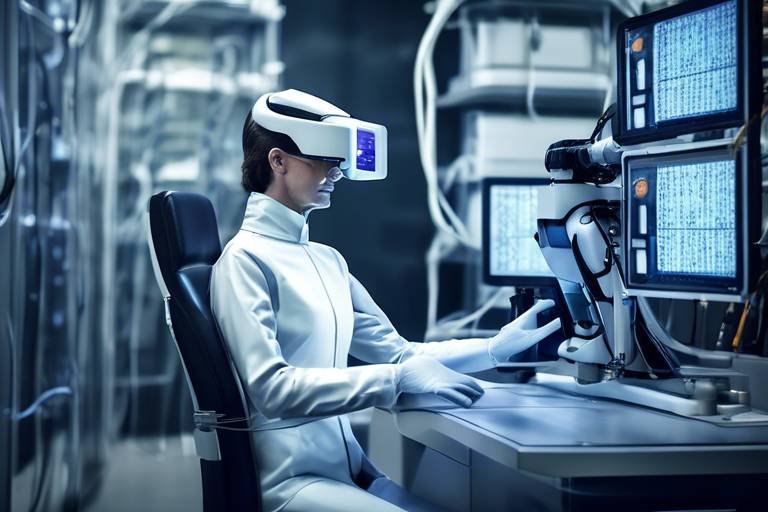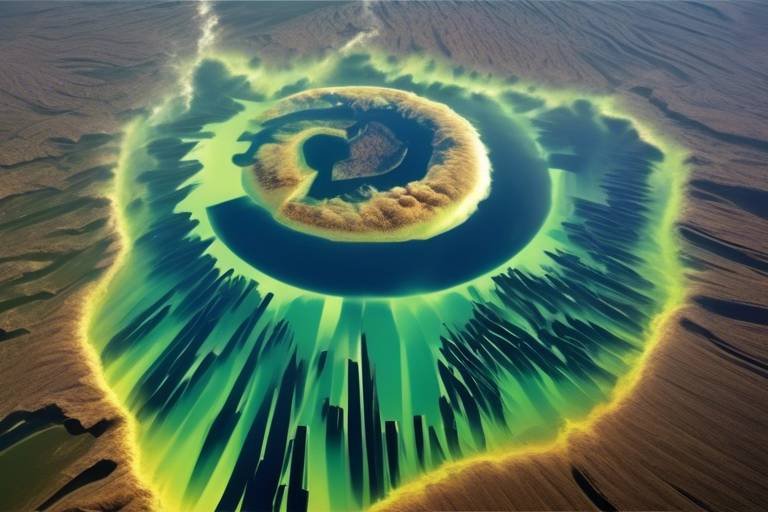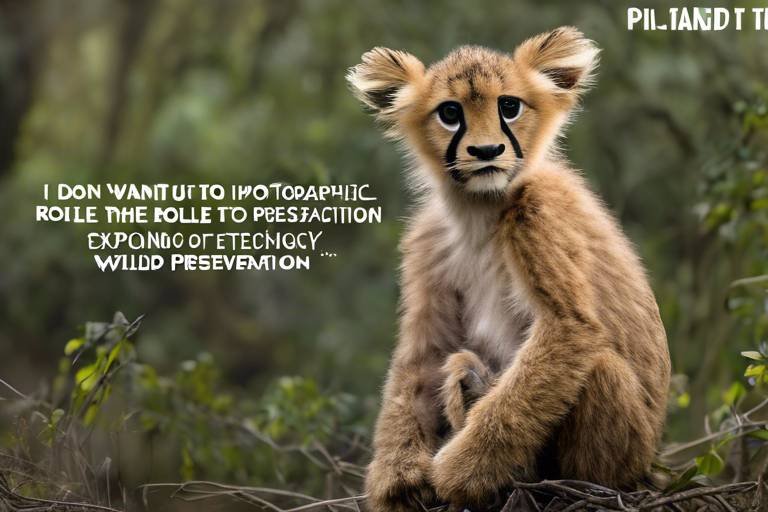How Technology is Advancing Marine Conservation
In recent years, the intersection of technology and marine conservation has become a beacon of hope for our oceans. As we face unprecedented challenges such as climate change, pollution, and overfishing, innovative technologies are emerging as powerful allies in the fight to protect marine ecosystems. Imagine a world where scientists can monitor the health of coral reefs from the comfort of their computers or where everyday citizens contribute to conservation efforts through their smartphones. This is not just a dream; it’s a reality that is unfolding right before our eyes. By harnessing the power of cutting-edge technologies, we are not only enhancing our understanding of marine environments but also taking actionable steps toward their preservation.
From remote sensing technologies that provide critical data on ocean conditions to underwater drones that explore the depths of the sea, the tools at our disposal are revolutionizing marine research and conservation strategies. These advancements allow us to collect data more efficiently, monitor changes in ecosystems in real-time, and develop targeted conservation initiatives that are crucial for the sustainability of our oceans. As we dive deeper into this topic, you'll discover how various technologies are shaping the future of marine conservation and why they are essential in our quest to safeguard these vital ecosystems.
Remote sensing technologies are at the forefront of marine conservation, providing invaluable data about ocean conditions and ecosystems. These tools enable scientists to monitor changes in marine environments from a distance, facilitating the assessment of their health and vitality. Imagine being able to observe the vastness of the ocean without having to set foot on a boat! With satellites and aerial drones, researchers can gather information on temperature, salinity, and even the presence of harmful algal blooms.
This data is crucial for understanding how climate change impacts marine life and ecosystems. For instance, remote sensing can help identify areas that are experiencing stress due to rising temperatures or pollution. By analyzing this information, scientists can prioritize regions that need immediate attention and develop strategies to mitigate the effects of human activity. In essence, remote sensing acts as our eyes in the sky, providing a comprehensive overview of the ocean's health and guiding conservation efforts.
Underwater drones are truly revolutionizing marine research! These incredible machines allow for real-time exploration and data collection in areas of the ocean that were once thought to be inaccessible. Imagine sending a drone down into the depths of the sea, capturing stunning footage of marine life, and collecting data that can inform conservation strategies. This technology enhances our understanding of marine ecosystems like never before.
Using underwater drones, researchers can create detailed maps of marine habitats, which are essential for understanding biodiversity. These maps reveal the intricate structures of coral reefs, seagrass beds, and other vital ecosystems. By identifying regions that require protection, scientists can focus conservation efforts where they are needed most. It’s like having a treasure map for marine life!
3D mapping techniques take this a step further, providing a comprehensive view of underwater topography. This advanced technology reveals critical habitats and geological features that support marine biodiversity. By visualizing the ocean floor in three dimensions, researchers can better understand how different species interact with their environment, leading to more effective conservation strategies.
Underwater drones also facilitate the monitoring of marine species, allowing scientists to track their movements and behaviors. This information is essential for developing effective conservation strategies. For example, understanding migratory patterns can help identify critical habitats that need protection, ensuring that marine species have safe passage during their journeys.
The integration of data analysis and artificial intelligence (AI) into marine conservation efforts enhances our ability to process vast amounts of marine data. With AI, scientists can analyze patterns and trends in marine ecosystems, leading to more informed conservation decisions. This technology allows us to predict how marine environments will respond to various stressors, ultimately guiding our conservation strategies.
Citizen science initiatives are another exciting aspect of technology in marine conservation. By leveraging technology, these initiatives engage the public in conservation efforts, enabling individuals to contribute valuable data and observations from their local waters. Imagine being part of a community that helps protect marine life simply by using an app on your phone!
Mobile applications empower citizens to report marine wildlife sightings and environmental changes. This fosters community involvement in conservation efforts and increases awareness of marine issues. By participating in citizen science, individuals can play a vital role in protecting marine ecosystems, making them feel more connected to the ocean.
Technology-driven education and outreach programs help raise awareness about marine conservation. These programs equip individuals with the knowledge and tools needed to protect marine ecosystems effectively. Whether through online courses, interactive websites, or social media campaigns, technology is making marine conservation more accessible to everyone.
Innovative monitoring systems, such as acoustic sensors and satellite tracking, provide real-time data on marine species and environmental conditions. These advancements enhance conservation management strategies, allowing researchers to make timely decisions based on accurate data. It’s like having a live feed from the ocean!
Acoustic monitoring systems allow researchers to track the sounds of marine life. This technology provides insights into species behaviors and habitat use, which is crucial for effective conservation planning. By understanding how marine species communicate and interact, we can better protect their habitats.
Satellite tracking enables scientists to monitor the movements of migratory marine species. This information is vital for informing conservation efforts and policies aimed at protecting critical habitats along migration routes. By understanding where these species go, we can create targeted conservation strategies that ensure their survival.
- What is marine conservation? Marine conservation refers to the protection and preservation of ocean ecosystems and marine life.
- How does technology help in marine conservation? Technology aids in data collection, monitoring, and analysis, allowing for more informed conservation strategies.
- What are underwater drones used for? Underwater drones are used for exploring marine environments, mapping habitats, and monitoring marine species.
- How can I get involved in marine conservation? You can participate in citizen science initiatives, report sightings through mobile apps, or join local conservation organizations.

Remote Sensing Technologies
This article explores the innovative technologies that are transforming marine conservation efforts, enhancing data collection, monitoring, and protection of marine ecosystems for a sustainable future.
Remote sensing technologies are nothing short of a game changer in the realm of marine conservation. Imagine being able to monitor the vastness of the ocean from the comfort of your home or a research lab—this is precisely what these technologies enable. By utilizing satellite imagery and aerial drones, scientists can gather critical data on ocean conditions and ecosystems without ever having to set foot in the water. This non-invasive approach not only saves time and resources but also allows for the continuous monitoring of changes in marine environments.
One of the most significant benefits of remote sensing is its ability to provide a comprehensive overview of ocean health. For instance, satellite images can reveal changes in water temperature, chlorophyll concentration, and even the presence of harmful algal blooms. This data is vital for assessing the impact of climate change and human activities on marine ecosystems. With this technology, researchers can:
- Track shifts in marine species distributions
- Monitor coral reef health
- Assess the impact of pollution on coastal areas
Moreover, remote sensing technologies facilitate the creation of detailed maps that visualize underwater habitats. These maps are essential for understanding biodiversity and identifying areas that require urgent conservation efforts. For example, researchers can highlight regions where marine life is thriving and contrast that with areas suffering from degradation. This visual representation makes it easier for policymakers and conservationists to prioritize their actions effectively.
In addition to mapping, remote sensing also plays a crucial role in predicting future changes in marine environments. By analyzing historical data alongside current observations, scientists can develop models that forecast how ecosystems might respond to various stressors, such as climate change or overfishing. This predictive capability is invaluable for proactive conservation strategies, enabling stakeholders to take action before a crisis occurs.
To sum it up, remote sensing technologies are revolutionizing marine conservation by providing essential data that informs decision-making, enhances monitoring capabilities, and supports the protection of vital marine ecosystems. As technology continues to evolve, we can expect even more innovative solutions that will further empower conservation efforts worldwide.
Q: What are remote sensing technologies?
A: Remote sensing technologies involve the use of satellite imagery and aerial drones to collect data about the Earth's surface, including oceans, without direct contact.
Q: How do remote sensing technologies benefit marine conservation?
A: They provide critical data on ocean conditions, help in mapping habitats, and allow for continuous monitoring of changes in marine environments, which is essential for effective conservation strategies.
Q: Can remote sensing predict future changes in marine ecosystems?
A: Yes, by analyzing historical data alongside current observations, scientists can develop models that forecast potential changes, enabling proactive conservation measures.

Underwater Drones
Underwater drones are not just a technological marvel; they are a game-changer in the field of marine research and conservation. Imagine being able to explore the depths of the ocean without getting wet! These innovative devices allow scientists and researchers to venture into previously inaccessible areas of the sea, gathering invaluable data in real-time. With the ability to navigate through complex underwater environments, underwater drones are reshaping how we understand marine life and ecosystems.
One of the most exciting aspects of underwater drones is their capability to map marine habitats in stunning detail. Using advanced imaging technologies, these drones can create high-resolution maps that reveal the intricate structures of coral reefs, seagrass beds, and other vital ecosystems. This detailed mapping is essential for identifying areas that require protection and conservation efforts. For instance, by analyzing the health and biodiversity of these habitats, researchers can prioritize regions that are under threat and develop targeted strategies to safeguard them.
Through the use of underwater drones, researchers are equipped to generate detailed habitat maps that provide a wealth of information about marine biodiversity. These maps allow scientists to visualize the distribution of various species and understand their interactions within the ecosystem. It’s like having a treasure map that not only shows where the treasures are buried but also highlights the paths that lead to them. This knowledge is crucial for effective conservation planning and management.
One of the standout features of underwater drones is their ability to utilize 3D mapping techniques. These techniques give researchers a comprehensive view of underwater topography, revealing essential habitats and geological features that support marine biodiversity. Imagine peering into a three-dimensional world where you can see the contours of the ocean floor, the heights of underwater mountains, and the valleys of deep-sea trenches. This rich visual data is invaluable for understanding the ecological dynamics of marine environments.
Underwater drones also play a pivotal role in monitoring marine species. By tracking the movements and behaviors of various marine organisms, scientists can gather critical data that informs conservation strategies. For example, understanding migration patterns of fish and marine mammals can lead to better policies for protecting their habitats. With the ability to collect data over extended periods, these drones help build a comprehensive picture of marine life, which is essential for effective conservation efforts.
In summary, underwater drones are revolutionizing marine research by providing unprecedented access to the ocean's depths. They are not just tools for exploration; they are vital instruments for conservation, enabling us to gather data that was previously out of reach. As we continue to harness the power of technology, the potential for underwater drones to contribute to marine conservation is boundless.
- What are underwater drones?
Underwater drones are remotely operated vehicles that can explore underwater environments, collect data, and capture images without human divers needing to be present.
- How do underwater drones help in conservation?
They provide real-time data on marine habitats, monitor species, and create detailed maps, which are essential for effective conservation planning.
- Are underwater drones safe to use?
Yes, underwater drones are designed to operate safely in various marine environments and can be deployed without disturbing marine life.
- Can anyone use underwater drones?
While they can be operated by trained professionals, there are also user-friendly models available for educational and recreational purposes.

Mapping Marine Habitats
Mapping marine habitats is akin to creating a treasure map, where every detail counts and every feature holds significance. With the advent of underwater drones, researchers are now equipped to delve into the depths of our oceans, uncovering the hidden gems of biodiversity that lie beneath the waves. These drones, which can navigate through previously inaccessible areas, are revolutionizing the way we understand marine ecosystems. Imagine being able to explore the vibrant coral reefs, kelp forests, and seagrass beds without the limitations of traditional diving methods. This technology not only enhances our ability to gather data but also allows us to visualize the intricate web of life that thrives underwater.
Using advanced mapping techniques, scientists can create detailed, high-resolution maps of marine habitats. These maps are essential for several reasons:
- Identifying Biodiversity Hotspots: By pinpointing areas with high species diversity, conservationists can prioritize them for protection.
- Assessing Habitat Health: Detailed maps help in assessing the health of various marine ecosystems, indicating areas that may be under threat from pollution or climate change.
- Guiding Restoration Efforts: Understanding the layout of marine habitats aids in planning effective restoration initiatives, ensuring that efforts are focused where they are most needed.
Furthermore, the integration of 3D mapping techniques has added a new dimension to our understanding of underwater landscapes. These techniques provide a comprehensive view of underwater topography, revealing critical habitats and geological features that support marine biodiversity. For instance, the intricate structures of coral reefs can be mapped in three dimensions, allowing researchers to study their complexity and the various niches they provide for marine life. This is crucial because the more we understand these habitats, the better we can protect them.
Moreover, the data collected through these mapping efforts can be analyzed to track changes over time. This is particularly important in the context of climate change, where rising sea temperatures and acidification are altering marine environments. By continuously updating habitat maps, scientists can monitor shifts in ecosystem boundaries and species distributions, enabling timely conservation actions. The ability to visualize these changes not only enhances scientific understanding but also serves as a powerful tool for raising awareness among policymakers and the general public about the pressing need for marine conservation.
In summary, mapping marine habitats using underwater drones and advanced technologies is transforming our approach to marine conservation. It allows us to uncover the mysteries of the ocean, identify critical areas for protection, and adapt our strategies in response to environmental changes. As we continue to explore and understand these underwater realms, we open the door to a future where marine ecosystems can thrive, benefiting both the planet and humanity.
Q: What are underwater drones?
A: Underwater drones, also known as remotely operated vehicles (ROVs), are unmanned submersibles that can explore and collect data from the ocean depths without human presence.
Q: How do mapping techniques benefit marine conservation?
A: Mapping techniques provide detailed insights into marine habitats, helping identify biodiversity hotspots, assess habitat health, and guide restoration efforts.
Q: Why is 3D mapping important?
A: 3D mapping offers a comprehensive view of underwater topography, revealing critical habitats and aiding in the understanding of marine biodiversity and ecosystem dynamics.
Q: How can I get involved in marine conservation?
A: You can get involved by participating in citizen science initiatives, reporting wildlife sightings through mobile apps, or supporting local conservation organizations.

3D Mapping Techniques
When it comes to understanding the underwater world, are nothing short of revolutionary. Imagine being able to visualize the ocean floor in three dimensions, much like a topographical map of a mountain range. This technology allows researchers to create detailed and accurate representations of underwater habitats, revealing hidden treasures that would otherwise remain unseen. By employing advanced sonar systems and underwater drones, scientists can capture intricate details of the ocean's topography, including reefs, trenches, and other geological features.
These 3D maps are invaluable for a multitude of reasons. First, they provide critical insights into the biodiversity of marine ecosystems. By understanding the structure of these habitats, researchers can identify areas that are rich in species and those that are more vulnerable to environmental changes. For instance, coral reefs, which are often referred to as the "rainforests of the sea," can be mapped to show their health and distribution. This information is crucial for conservation efforts, as it helps prioritize regions that need immediate protection.
Moreover, the data collected through 3D mapping techniques can be used to track changes over time. As the ocean faces threats from climate change, pollution, and overfishing, these maps serve as a baseline against which future changes can be measured. For example, researchers can observe how a coral reef's structure alters due to bleaching events or how sedimentation affects the surrounding marine life. This dynamic monitoring is essential for developing effective conservation strategies and ensuring the sustainability of marine ecosystems.
To illustrate the power of 3D mapping, consider the following table that outlines some of the key benefits:
| Benefits of 3D Mapping Techniques | Description |
|---|---|
| Enhanced Visualization | Provides a detailed view of marine habitats, aiding in better understanding and research. |
| Biodiversity Insights | Helps identify critical habitats and species richness, guiding conservation efforts. |
| Dynamic Monitoring | Enables tracking of changes in ecosystems over time, essential for adaptive management. |
| Community Engagement | Encourages public involvement in marine conservation through accessible data. |
In essence, 3D mapping techniques are not just tools for researchers; they are gateways to a deeper understanding of our oceans. By harnessing this technology, we can better protect the marine environments that are vital to our planet's health. The future of marine conservation is bright, and with the integration of innovative mapping methods, we are one step closer to ensuring that our oceans thrive for generations to come.
Q: What are 3D mapping techniques?
A: 3D mapping techniques use advanced sonar and underwater drones to create detailed three-dimensional representations of underwater habitats, revealing critical geological features and biodiversity.
Q: How does 3D mapping benefit marine conservation?
A: It provides insights into habitat structure, tracks changes over time, and helps identify critical areas for protection, ultimately guiding effective conservation strategies.
Q: Can the public access 3D mapping data?
A: Yes, many research initiatives aim to make 3D mapping data available to the public, promoting community involvement in marine conservation efforts.

Monitoring Marine Species
Monitoring marine species is a crucial aspect of marine conservation, and underwater drones are at the forefront of this technological revolution. These innovative devices allow researchers to observe marine life in their natural habitats without disturbing them. Imagine being able to explore the depths of the ocean, witnessing the intricate behaviors of fish, sea turtles, and even elusive sharks, all while remaining at a safe distance! This capability not only enhances our understanding of marine ecosystems but also plays a pivotal role in developing effective conservation strategies.
One of the significant advantages of using underwater drones is their ability to collect real-time data on marine species' movements and behaviors. For instance, researchers can deploy these drones to track the migration patterns of various fish species, which is vital for understanding their life cycles and habitat preferences. By observing these patterns, scientists can identify critical breeding and feeding grounds that require protection, ensuring the sustainability of these species for future generations.
Moreover, the data collected by underwater drones can be analyzed to reveal trends over time. This long-term monitoring is essential for assessing the health of marine populations and understanding the impacts of environmental changes, such as climate change and pollution. For example, if a particular species is observed to be declining in numbers, conservationists can take immediate action to address the threats they face, whether it's through establishing protected areas or implementing fishing regulations.
In addition to tracking movements, underwater drones can also monitor the interactions between different marine species. This is particularly important in ecosystems where certain species play a key role in maintaining balance. For example, the presence of apex predators, like sharks, can influence the population dynamics of smaller fish species. By understanding these interactions, conservationists can develop more holistic management strategies that take the entire ecosystem into account.
Furthermore, the integration of advanced technologies such as machine learning and artificial intelligence with drone data is revolutionizing how we monitor marine species. These technologies can process vast amounts of data quickly, identifying patterns and anomalies that might be missed by human observers. This means that researchers can focus on interpreting the data and making informed decisions rather than getting bogged down in data collection.
In conclusion, the monitoring of marine species through underwater drones is not just a technological advancement; it is a game-changer for marine conservation. By providing unprecedented access to the underwater world, these tools enable scientists to gather vital information that is essential for protecting our oceans and the diverse life within them. As we continue to innovate and improve these technologies, the future of marine conservation looks brighter than ever.
- What are underwater drones? Underwater drones are remotely operated vehicles designed to explore and collect data from underwater environments.
- How do underwater drones help in marine conservation? They allow researchers to monitor marine species, track their movements, and gather data without disturbing their natural habitats.
- What kind of data can be collected using underwater drones? Data on species behavior, population dynamics, habitat use, and environmental conditions can be collected.
- Can anyone use underwater drones for marine research? While technology is becoming more accessible, proper training and permissions are often required for scientific research.
- How does AI enhance the use of underwater drones? AI can analyze large datasets collected by drones, identifying trends and patterns that inform conservation strategies.

Data Analysis and AI
In recent years, the integration of data analysis and artificial intelligence (AI) has become a game-changer in the realm of marine conservation. Just imagine the vast oceans filled with data, from temperature fluctuations to species migration patterns, and how overwhelming that can be! But with the right technological tools, we can sift through this ocean of information to uncover critical insights that help protect our marine ecosystems.
AI algorithms can process and analyze data at a speed and accuracy that far surpasses human capabilities. For instance, machine learning models can identify patterns in data collected from various sources, such as underwater drones, satellite imagery, and acoustic sensors. This capability allows scientists to predict changes in marine environments and species behavior, leading to timely and effective conservation measures.
One of the most fascinating applications of AI in marine conservation is its ability to enhance species identification. By training AI models on vast datasets of marine life images, researchers can develop systems that automatically recognize different species in real-time. This not only saves time but also increases the accuracy of species monitoring. For example, when researchers deploy underwater cameras, AI can instantly analyze the footage and provide data on species diversity and population counts.
Moreover, the combination of data analysis and AI can facilitate the creation of predictive models that help in understanding the impact of environmental changes on marine ecosystems. By analyzing historical data alongside real-time data, these models can forecast potential threats, such as climate change, pollution, and overfishing. This proactive approach enables conservationists to implement strategies before a crisis occurs, making a significant difference in the preservation of marine life.
To illustrate the power of data analysis and AI, consider the following table that outlines some of the key benefits these technologies bring to marine conservation efforts:
| Benefit | Description |
|---|---|
| Enhanced Monitoring | AI systems can process data from various sources to provide real-time monitoring of marine species and habitats. |
| Predictive Analytics | Using historical data, AI can predict future trends and threats to marine ecosystems. |
| Species Identification | AI can automatically identify species from images and videos, improving data accuracy. |
| Resource Optimization | Data analysis helps in allocating resources effectively for conservation efforts. |
As we continue to harness the power of data analysis and AI, the future of marine conservation looks promising. These technologies not only empower researchers but also engage the public in the fight to protect our oceans. By making data more accessible and understandable, we can inspire a new generation of marine stewards dedicated to preserving the beauty and biodiversity of our seas.
In conclusion, the marriage of data analysis and AI is revolutionizing how we approach marine conservation. It’s like having a superpower that allows us to see beyond the surface and understand the intricate web of life in our oceans. As we embrace these advancements, we take significant steps toward a sustainable future for marine ecosystems.
- What role does AI play in marine conservation? AI helps in processing large datasets, identifying species, and predicting environmental changes, which aids in conservation efforts.
- How can citizens contribute to marine conservation using technology? Citizens can use mobile apps to report sightings and environmental changes, participating in data collection and awareness initiatives.
- What are some examples of remote sensing technologies? Remote sensing technologies include satellite imagery and aerial drones that monitor ocean conditions and marine ecosystems.
- Why is data analysis important for marine conservation? Data analysis allows researchers to make informed decisions, identify trends, and implement effective conservation strategies based on evidence.

Citizen Science Initiatives
Citizen science initiatives are a game-changer in the realm of marine conservation. They harness the collective power of individuals to gather data, monitor ecosystems, and raise awareness about the challenges our oceans face. Imagine a world where every beachgoer, snorkeler, or fisherman can contribute to scientific research simply by using their smartphone! This is not just a dream; it’s happening right now, and it’s transforming how we understand and protect our marine environments.
One of the most exciting aspects of these initiatives is the use of mobile applications that allow everyday people to report their observations. For instance, apps like iNaturalist and Marine Debris Tracker empower users to document marine wildlife sightings and environmental changes. When someone spots a rare fish species or notices an increase in plastic waste on a beach, they can instantly log this information through their phone. This data is then aggregated and analyzed by scientists, providing invaluable insights into marine biodiversity and the health of ecosystems.
Moreover, citizen science fosters a sense of community and responsibility. When individuals participate in these initiatives, they become more aware of the issues affecting marine life. They learn about the importance of conservation and are motivated to make changes in their own lives. This ripple effect can lead to broader community engagement in protecting marine ecosystems. It’s not just about collecting data; it’s about creating a movement where everyone feels like they have a stake in the health of our oceans.
Education plays a crucial role in these initiatives. By incorporating technology-driven education and outreach programs, organizations can equip individuals with the knowledge and tools necessary to make a difference. Workshops, online courses, and interactive webinars can teach participants about marine ecosystems, conservation techniques, and the impact of human activity on the ocean. This educational component not only enhances the quality of data collected but also inspires participants to advocate for marine protection in their communities.
| Citizen Science Benefits | Description |
|---|---|
| Data Collection | Engages the public in gathering vital data on marine species and habitats. |
| Community Involvement | Fosters a sense of responsibility and connection to marine environments. |
| Education | Increases awareness and knowledge about marine conservation issues. |
| Real-time Monitoring | Provides timely data that can influence conservation strategies and policies. |
In conclusion, citizen science initiatives are not just a trend; they are a vital part of the modern conservation toolbox. By leveraging technology and the enthusiasm of the public, we can gather critical data and foster a culture of conservation. As more individuals join the movement, the potential for positive impact on marine ecosystems grows exponentially. So, the next time you’re near the water, consider how you can contribute to this vital cause. Your observations could help shape the future of marine conservation!
- What is citizen science? Citizen science involves public participation in scientific research, allowing non-professionals to contribute to data collection and analysis.
- How can I get involved in citizen science initiatives? You can participate by downloading mobile apps designed for reporting wildlife sightings, joining local conservation groups, or attending workshops.
- What are the benefits of citizen science? Benefits include increased data collection, community engagement, enhanced education, and real-time monitoring of ecosystems.
- Are there specific apps for marine conservation? Yes, popular apps include iNaturalist, Marine Debris Tracker, and Ocean Conservancy’s Clean Swell.

Mobile Apps for Reporting
In today's digital age, mobile applications have emerged as powerful tools for enhancing marine conservation efforts. These apps serve as a bridge between scientists and the general public, enabling individuals to contribute valuable data from their local waters. Imagine walking along the beach, spotting a rare marine species, and having the ability to report it instantly through your smartphone. This is not just a dream; it's a reality thanks to innovative mobile apps designed specifically for marine conservation.
These applications often come equipped with user-friendly interfaces that allow users to easily input their observations. Whether it's a sighting of a dolphin, a sea turtle nesting, or even pollution in the water, every piece of information contributes to a larger database that researchers can analyze. By harnessing the collective power of citizen scientists, we can gather data that would be impossible to collect otherwise. This approach not only enhances data collection but also fosters a sense of community and shared responsibility among users.
Many of these apps feature interactive maps that allow users to pinpoint the exact location of their sightings, which can be crucial for tracking migration patterns or identifying hotspots of biodiversity. For instance, the app might ask users to categorize their sightings by species, condition, and behavior. This structured data collection can significantly improve the quality of information available to marine biologists and conservationists.
Some popular mobile apps for reporting marine wildlife include:
- Marine Debris Tracker: This app allows users to report and map marine debris, helping to address pollution issues.
- iNaturalist: A platform where users can document and share their wildlife observations, contributing to a global biodiversity database.
- Ocean Conservancy: This app enables users to track their clean-up efforts and report marine wildlife sightings.
Moreover, these mobile apps often incorporate educational features that inform users about local marine ecosystems and the importance of conservation. For instance, upon reporting a sighting, users might receive information about the species they observed, its role in the ecosystem, and tips on how to protect it. This not only empowers users with knowledge but also encourages them to become advocates for marine conservation.
In conclusion, mobile apps for reporting are transforming the landscape of marine conservation. They empower individuals to take an active role in protecting our oceans, turning everyday citizens into vital contributors to scientific research. As we continue to develop and refine these technologies, the potential for community engagement in conservation efforts will only grow, leading to a healthier and more sustainable marine environment.
Q: How can I get involved with marine conservation using mobile apps?
A: You can start by downloading popular marine conservation apps like Marine Debris Tracker or iNaturalist. These apps allow you to report sightings and contribute to important research efforts.
Q: Are there any specific requirements to use these apps?
A: Most mobile apps for reporting marine wildlife are user-friendly and do not require any special skills. Just follow the prompts in the app to submit your observations.
Q: Can my contributions really make a difference?
A: Absolutely! Every report adds to the collective knowledge about marine ecosystems and helps researchers make informed conservation decisions.

Education and Outreach
Education and outreach play a pivotal role in marine conservation efforts, acting as the bridge between scientific knowledge and public awareness. By utilizing technology, organizations and researchers can effectively disseminate crucial information about marine ecosystems, the threats they face, and the actions individuals can take to protect them. Imagine a world where every person feels empowered to make a difference; that's the vision behind these initiatives.
One of the most effective ways to engage the public is through interactive online platforms and educational mobile applications. These tools not only provide information but also create a sense of community among users. For instance, apps that allow users to track and report marine life sightings can turn everyday beachgoers into citizen scientists. This not only enhances data collection but also fosters a deeper connection to the ocean and its inhabitants.
Moreover, social media campaigns have proven to be incredibly effective in raising awareness about marine conservation issues. They allow organizations to reach a broader audience and engage with individuals who might not otherwise be aware of marine threats. Through eye-catching visuals and compelling stories, these campaigns can inspire action and encourage individuals to participate in local conservation efforts.
In addition to digital outreach, hands-on educational programs are equally important. Workshops, community clean-up events, and school programs offer practical experiences that highlight the importance of marine conservation. These initiatives not only educate participants about marine ecosystems but also empower them to take action in their own communities. For example, a local beach clean-up can transform into a powerful learning experience, where participants discover the impact of plastic pollution on marine life.
To illustrate the impact of education and outreach, consider the following table that outlines key statistics related to community involvement in marine conservation:
| Year | Number of Workshops Held | Participants Engaged | Marine Species Sightings Reported |
|---|---|---|---|
| 2020 | 50 | 1,200 | 350 |
| 2021 | 75 | 2,500 | 600 |
| 2022 | 100 | 3,800 | 900 |
As we can see, there has been a significant increase in community engagement over the years, highlighting the effectiveness of educational outreach programs. When people are informed and involved, they are more likely to take action to protect marine environments.
In conclusion, the fusion of education and technology in marine conservation outreach is not just beneficial; it is essential. By empowering individuals with knowledge and tools, we can cultivate a generation of informed advocates for our oceans. The future of marine conservation depends on our collective efforts, and through education, we can inspire a wave of positive change.
Q: How can I get involved in marine conservation efforts?
A: There are many ways to get involved, from participating in local clean-up events to joining citizen science initiatives that track marine life. Check out local organizations or online platforms for opportunities.
Q: What role does technology play in marine conservation?
A: Technology enhances data collection, monitoring, and outreach efforts, allowing for more effective conservation strategies. Tools like mobile apps and online platforms help engage the public and gather valuable data.
Q: Why is education important for marine conservation?
A: Education raises awareness about marine issues and empowers individuals to take action. Informed communities are more likely to participate in conservation efforts and advocate for policies that protect marine ecosystems.

Innovative Monitoring Systems
In the realm of marine conservation, are becoming indispensable tools for researchers and conservationists alike. These systems not only provide real-time data on marine species and environmental conditions but also enhance our understanding of the delicate ecosystems that thrive beneath the ocean's surface. Imagine being able to listen to the symphony of marine life or track the migration of species across vast oceans—this is the power that modern technology brings to marine conservation.
Among the most exciting advancements are acoustic sensors and satellite tracking systems. These technologies allow scientists to gather extensive data that was previously difficult or impossible to obtain. For instance, acoustic monitoring provides insights into the sounds of marine life, revealing vital information about species behaviors and habitat usage. By analyzing these sounds, researchers can decipher patterns that inform conservation strategies. It's like having an underwater eavesdropper, giving us a glimpse into the lives of creatures that we rarely see.
On the other hand, satellite tracking has revolutionized how we monitor migratory marine species. This technology enables scientists to follow the movements of animals like turtles, whales, and sharks across their migratory routes, offering crucial data that can influence conservation policies. Understanding where these species go and what challenges they face along the way is essential for protecting their habitats and ensuring their survival. The data collected can be visualized in comprehensive maps, showcasing migration patterns and highlighting critical areas that need protection.
| Monitoring System | Key Features | Benefits |
|---|---|---|
| Acoustic Sensors | Tracks sounds of marine life, analyzes species behavior | Informs conservation planning, enhances understanding of ecosystems |
| Satellite Tracking | Monitors migratory patterns of marine species | Informs policies, protects critical habitats |
The integration of these monitoring systems not only aids scientists but also empowers conservation organizations to make data-driven decisions. By using real-time data, they can respond promptly to environmental changes, such as shifts in water temperature or the presence of pollutants. This proactive approach is crucial in a world where climate change and human activities threaten marine ecosystems.
Moreover, these innovative systems encourage collaboration among researchers, policymakers, and the public. As data becomes more accessible, it fosters a sense of shared responsibility for marine conservation. Communities can engage in conservation efforts, armed with information that helps them understand the importance of protecting their local marine environments.
In conclusion, the advent of innovative monitoring systems marks a significant leap forward in marine conservation. By harnessing the power of technology, we are not only enhancing our understanding of marine ecosystems but also taking crucial steps towards ensuring their sustainability for future generations. The ocean is a vast and mysterious world, and with these advancements, we are beginning to unlock its secrets.
- What are innovative monitoring systems? These are advanced technologies like acoustic sensors and satellite tracking that help monitor marine species and environmental conditions.
- How do acoustic sensors work? Acoustic sensors track the sounds produced by marine life, providing insights into their behaviors and habitats.
- Why is satellite tracking important? Satellite tracking allows scientists to monitor the migratory patterns of marine species, which is essential for effective conservation efforts.
- Can the public get involved in marine conservation? Yes! With the help of technology, individuals can participate in citizen science initiatives and contribute valuable data.

Acoustic Monitoring
Acoustic monitoring is a groundbreaking approach that allows researchers to listen in on the vibrant sounds of the ocean, providing a unique window into the lives of marine species. Imagine being able to eavesdrop on the conversations of whales or the clicks of dolphins as they navigate their underwater world. This technology not only enhances our understanding of marine life but also plays a crucial role in conservation efforts. By deploying underwater microphones, or hydrophones, scientists can capture the myriad sounds produced by marine organisms, which can indicate their presence, behaviors, and even their responses to environmental changes.
Acoustic monitoring is particularly valuable for studying elusive species that are difficult to observe directly. For example, some fish and marine mammals are known for their vocalizations, which can be recorded and analyzed to gather important data. This method allows researchers to track the abundance and distribution of these species over time, providing insights that are essential for effective conservation planning. The data collected through acoustic monitoring can reveal patterns in migration, breeding, and feeding behaviors, all of which are critical for developing strategies to protect these vulnerable populations.
Moreover, acoustic monitoring can also serve as an early warning system for environmental changes. For instance, a sudden decline in the sounds of a particular species could indicate a change in habitat quality or the presence of a threat, such as pollution or overfishing. By continuously monitoring these acoustic signals, conservationists can respond more swiftly to emerging issues, potentially mitigating the impact on marine ecosystems.
To put it simply, acoustic monitoring is like having a high-tech listening device that helps us decipher the complex symphony of the ocean. It allows us to create a comprehensive picture of marine life, revealing not just who is there, but how they interact with each other and their environment. This understanding is vital for crafting effective conservation policies aimed at preserving the delicate balance of marine ecosystems.
In summary, the integration of acoustic monitoring into marine conservation efforts represents a significant leap forward in our ability to understand and protect the ocean's inhabitants. As technology continues to evolve, so too does our capacity to safeguard the rich biodiversity that thrives beneath the waves.
- What is acoustic monitoring? Acoustic monitoring involves using hydrophones to record and analyze the sounds made by marine species, allowing researchers to gather data on their behaviors and populations.
- Why is acoustic monitoring important for conservation? It provides critical insights into the presence and health of marine species, helping to inform effective conservation strategies and respond to environmental changes.
- How does acoustic monitoring work? Researchers deploy underwater microphones to capture sounds in various marine environments, which are then analyzed to track species and their behaviors over time.
- Can acoustic monitoring help with habitat protection? Yes, by identifying changes in species vocalizations, researchers can detect shifts in habitat quality and take action to protect critical areas.

Satellite Tracking
When we think about the vastness of the ocean, it’s almost mind-boggling to consider how much of it remains unexplored. Enter , a groundbreaking technology that allows scientists to monitor the movements of migratory marine species like never before. Imagine being able to follow the journey of a whale as it swims thousands of miles across the ocean! This technology not only provides valuable data but also plays a crucial role in shaping conservation policies aimed at protecting these magnificent creatures and their habitats.
Satellite tracking works by attaching small, lightweight transmitters to marine animals. These devices send real-time data back to researchers, revealing the animals’ locations and movements. This information is vital for understanding migration patterns, breeding grounds, and feeding habits. For instance, researchers can track the seasonal movements of sea turtles, which often travel between nesting beaches and feeding areas. By mapping these routes, conservationists can identify critical habitats that need protection.
Moreover, the data collected through satellite tracking can be analyzed to reveal trends and changes in marine populations over time. For example, if a particular species is found to be migrating earlier in the year due to climate change, this information can prompt immediate conservation actions. The ability to visualize this data can be enhanced through interactive maps, which allow stakeholders to see the movements of different species in real time.
To illustrate the impact of satellite tracking, consider the following table that highlights some key marine species commonly monitored using this technology:
| Marine Species | Tracking Purpose | Key Findings |
|---|---|---|
| Leatherback Sea Turtle | Migration patterns | Identified critical nesting and feeding areas. |
| Bluefin Tuna | Spawning behavior | Revealed spawning locations essential for conservation. |
| Humpback Whale | Breeding grounds | Mapped migration routes to protect breeding habitats. |
In addition to tracking individual species, satellite technology also helps in monitoring the health of marine ecosystems. By observing how these species interact with their environment, scientists can gain insights into the overall health of oceanic regions. This is particularly important in areas that are under threat from overfishing, pollution, and climate change.
In conclusion, satellite tracking is not just a tool for researchers; it's a beacon of hope for marine conservation. As we gather more data and understand the intricate web of life in our oceans, we can make informed decisions to protect these vital ecosystems. The ocean is vast, but with the help of technology like satellite tracking, we can start to unravel its mysteries and safeguard its future.
- What is satellite tracking? Satellite tracking is a method used to monitor the movements of marine animals by attaching transmitters to them, which send real-time location data to researchers.
- How does satellite tracking help marine conservation? It helps by providing critical information on migration patterns, breeding grounds, and habitat use, allowing for better protection and management of marine species.
- What types of marine species can be tracked? Many species, including sea turtles, whales, and fish, can be tracked using satellite technology.
- Is satellite tracking safe for marine animals? Yes, the transmitters used are designed to be lightweight and minimally invasive, ensuring the safety and comfort of the animals.
Frequently Asked Questions
- What are remote sensing technologies and how do they benefit marine conservation?
Remote sensing technologies are tools that allow scientists to gather data about ocean conditions and ecosystems from afar. They help monitor changes in marine environments, assess health, and understand ecological dynamics without needing to be physically present.
- How do underwater drones enhance marine research?
Underwater drones are game-changers in marine research. They enable real-time exploration and data collection in areas that were once difficult to access. This technology allows researchers to study marine life more closely and gather crucial data that informs conservation efforts.
- What is the significance of 3D mapping techniques in marine conservation?
3D mapping techniques provide a detailed view of underwater topography, revealing essential habitats and geological features that support marine biodiversity. This detailed mapping helps identify regions that need protection, ensuring that conservation efforts are targeted and effective.
- How does data analysis and AI contribute to marine conservation?
The combination of data analysis and artificial intelligence allows for the processing of massive amounts of marine data quickly and efficiently. This leads to more informed decision-making and the development of effective conservation strategies based on real-time insights.
- What role do citizen science initiatives play in marine conservation?
Citizen science initiatives engage the public in conservation efforts, allowing individuals to contribute valuable observations and data from their local waters. This involvement not only empowers communities but also raises awareness about the importance of protecting marine ecosystems.
- How can mobile apps aid in marine conservation?
Mobile applications provide a platform for citizens to report marine wildlife sightings and environmental changes easily. By fostering community involvement, these apps help increase awareness of marine issues and encourage proactive conservation efforts.
- What innovative monitoring systems are being used in marine conservation?
Innovative monitoring systems, such as acoustic sensors and satellite tracking, provide real-time data on marine species and environmental conditions. These technologies enhance conservation management strategies by offering insights into species behaviors and habitat use.
- How does acoustic monitoring work in marine environments?
Acoustic monitoring involves tracking the sounds produced by marine life. This method provides researchers with valuable insights into species behaviors and habitat usage, which are crucial for planning effective conservation measures.
- What is the purpose of satellite tracking in marine conservation?
Satellite tracking allows scientists to monitor the movements of migratory marine species. This information is vital for informing conservation policies and protecting critical habitats along migration routes, ensuring the survival of these species.



















